The weekend before last, that is, Feb 27 it must have been, we drove up to Slattery’s Farm and Maple Supply store in West Minot (pronounced like what you do with coal, mine it) to get what we needed to collect maple sap. That was to say, some taps to put in the tree, buckets to hang on them to collect the sap, and covers to keep bugs, stray leaves, and everything else that’s out there in the woods that you don’t want in your maple syrup out of the sap. The woman minding the store, presumably Joni Slattery, was very helpful. “Become a tree hugger,” she said. “If you can get your arms around a tree and touch your hands on the other side, it’s big enough to put a tap in. If you can reach all the way around to your elbows, don’t tap it. If you can’t get your hands anywhere close to each other on the far side, you can put in two taps.” The other customers also were happy to give us some encouragement and pointers. I was thinking that we were spending some money on the deal, and that it was going to be an expensive way to get maple syrup, but I realized that if we got two gallons of syrup with the equipment before it wore out we would have broken even on it. It could happen. After we paid, Mrs. Slattery said, “and with a purchase over $30, you get a free 10 pound bag of potatoes!” So we got more than we bargained for.
Collecting the sap is just the start. You need 40 times as much sap as you’re going to end up with syrup, and the 39 parts that isn’s syrup is water that you have to boil away. So the key is how you’re going to boil down the sap. “A lot of people use propane, something like a propane turkey fryer,” said Mrs. Slattery. We saw a turkey fryer for sale on Craig’s List, but we really wanted just the burner part, not all the turkey wrangling parts. We stopped at Cabela’s, a big outdoor outfitter store, on the way north last Friday, to look for a burner. A very knowledgeable salesman said, “Really, the least expensive thing we have that will work for you is this fish fryer…” and it looked just right, for $40 instead of the $150 Craig’s List price for the turkey outfit. Add the propane tank, and it’s going to take more like six gallons of syrup before we break even; but it’s for the learning experience and, we hope, fun.
First thing Saturday morning, I took the taps, buckets, a hammer, and a drill out to the maple trees we had scouted out. You need to drill the hole slanted slightly upwards —
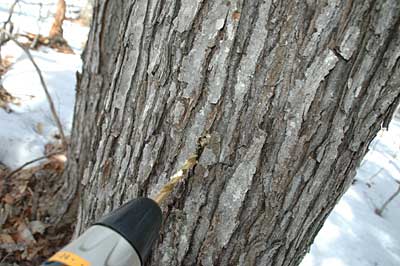
hammer in the tap (not too hard; you don’t want to split the wood, or the sap will flow out below the tap instead of through it) —
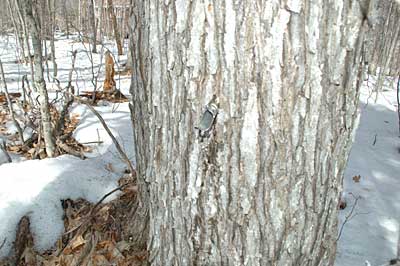
— hang a bucket on the hook that hooks through the tap, and put a cover on it —
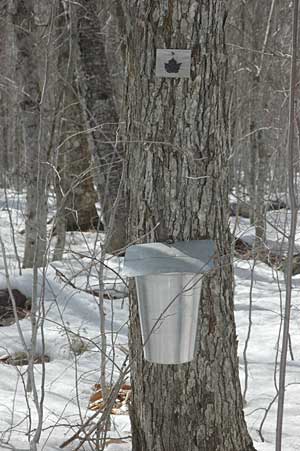
and that’s one tree tapped.
Before I drilled the first hole I wondered if it was really going to work. Before I had a chance to hammer in the first tap, it was clear that it was going to. There was sap dripping out of the hole immediately!
Of course I took lots of pictures of the process. I tried hard to catch the drops of sap dripping. This was perhaps the most successful picture:
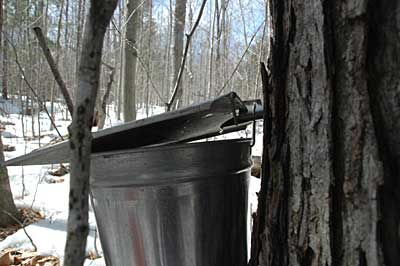
I put in three taps (because that was all the tappable-size maples we had found close to the house.) We went out to the local hardware store for a tank of propane (which could be a post in itself — but won’t.)
The next morning I collected the sap. None of the buckets was as much as half full, but the three together added up to more than half a bucket — probably five quarts of sap.
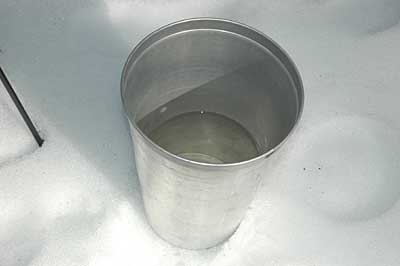
I hooked the propane up to the burner, poured a couple of inches worth of sap in the pot, and started boiling it. The burner put out a lot more heat than a stove burner. The sap started bubbling a lot sooner than a teakettle with half as much liquid boils, even though it was a watched pot.
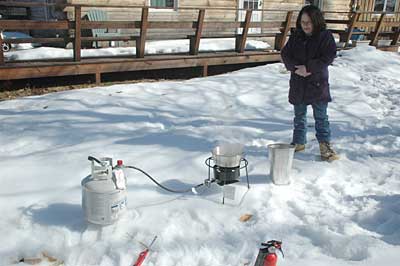
It would have been a better idea to warm up the sap that wasn’t in the pot yet, rather than having it on ice. I kept ladling in more sap as the pot boiled.
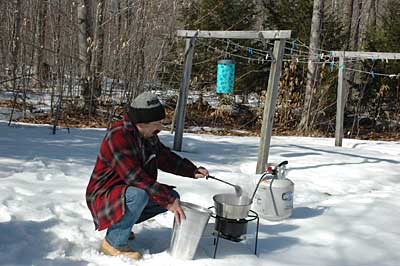
As the sap boiled down, it started to have a little of that golden maple syrup color
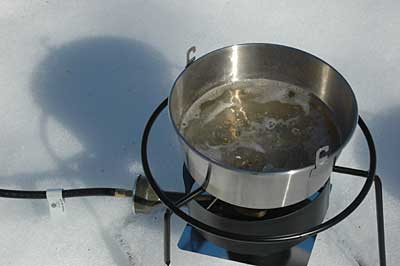
Syrup is done when the boiling temperature is 7 degrees above boiling (which isn’t 212, unless you’re right at sea level). The books say that you have to be really careful when it gets close to that temperature, or you may boil it over (and lose all that work!) or overdo it and end up with a scorched mess (also lose all that work). I brought the syrup indoors and finished it in a smaller pot on the stove when it had all boiled down to just a cup or two.
Finally, after I had been standing out in the snow for two hours and boiled down those five quarts of sap plus another quart that Arlene brought back before I had finished with the first batch, we had a little more than half a half-pint jelly jar of syrup!
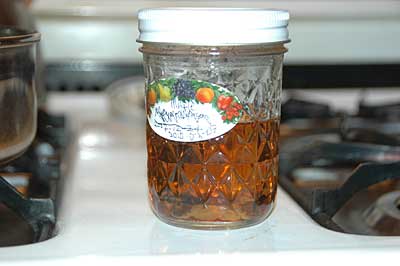
Arlene immediately scooped out two bowls of vanilla ice cream and put some syrup on it!
Wait, is that really me with all those exclamation points?